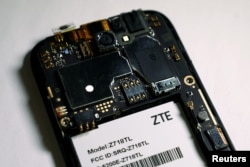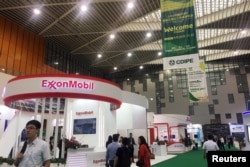The White House’s announcement this week that it will press ahead with tariffs on $50 billion in Chinese imports and other measures has left many wondering if a trade war between the world’s two biggest economies is really on hold.
Tuesday’s announcement has widely been viewed as a flip-flop on an agreement reached earlier this month to move away from trade tariff threats and focus on a broader deal.
In turn, the renewed threats have some arguing that the ability of Beijing and Washington to continue to negotiate and American credibility is at stake. Others, however, see President Donald Trump's approach giving Washington much needed traction to resolve long-standing concerns over China’s trade practices.
In it’s announcement, the White House said that by mid-June it will unveil a final list of tariffs and that by the end of the month, controls on exports and investments related to the “acquisition of industrially significant technologies” in the United States will follow.
China has called the tariff threats reckless, arguing that they violate World Trade Organization rules. It has also said it is prepared to retaliate if necessary. For now, it appears the announcement has not had an impact on the already planned trip by Commerce Secretary Wilbur Ross to visit Beijing this weekend.
David Dollar, a senior fellow at The Brookings Institution said the announcement just days after the two reached an initial deal was surprising.
He said it appears the president is reacting to negative press about the deal and its lack of details as well his administration’s controversial decision to spare Chinese telecommunications company ZTE from penalties that China said would put it out of business.
“I think he's gotten a fair amount of criticism from Congress and from the press and he seems to have hardened his attitude toward China in response to that,” Dollar said.
The agreement reached earlier in May focused largely on measures to reduce the trade deficit through energy and agricultural purchases. That is what Secretary Ross is expected to focus on during his visit to Beijing from June 2-4.
A joint statement issued by the two also talked about cooperation in addressing intellectual property, boosting two-way investment and creating a more fair and level playing field for competition. However, details on that were less specific.
Differing views within the administration about how to move forward may also be a factor.
“It [may] be a strategy. If so, I find such tactics too blatant and only make [the U.S. government] appear untrustworthy,” said Liao Qun, chief economist at China CITIC Bank International Limited. “Or it indicates an internal division [between the doves and the hawks], which Trump is finding hard to resolve. It’s hard to say, but I think both scenarios are likely.”
Penelope Prime, a business professor and founding director of the China Research Center at Georgia State University agrees the move could be a reflection of differing views within the White House as well as a perceived lack of progress so far by some.
“It's possibly a tactic or another tactic to get China to pay more attention to what we really want,” Prime said.
How effective a tactic that might be is a matter of debate. Prime believes it is bad for Washington’s credibility and gives hardliners in China ammunition to oppose moves to open up the economy.
Some in the foreign business community have noted that tariffs and the threat of using them has helped to get China to engage more on issues than it has in years and is giving Washington some leverage.
David Dollar of The Brookings Institution disagrees.
“Chinese exports to the U.S. in value added terms is less than 3 percent of their economy now,” he said. “So, I think the U.S. used to have a lot of leverage, now the U.S. doesn’t have a lot of leverage.”
Claire Reade, a former U.S. assistant trade representative for China Affairs said Beijing is not going to do whatever the United States wants just because that’s what Washington wants.
At the same time, she adds, Beijing does to some extent see that the problems the U.S. has identified are problems that are also holding the Chinese economy back.
“I do think that the Trump administration's disruptive approach to China trade and economic relations has awakened China without question,” Reade said. “China is, I think, actively trying to figure out what it can do and what it wants to do in response to these objections from the United States.”
Since the trade spat began heating up in March, China has agreed to cut import tariffs on automobiles and consumer goods. It has also pledged to go on a buying spree of agricultural and energy products as well as review laws related to intellectual property protection among other measures.
Brian Kopczynski contributed to this story









